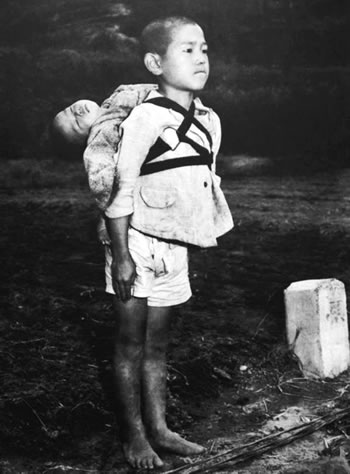
The photo shown here, enlarged to life size, stood beside the altar when our deceased Holy Father Pope Francis celebrated a Mass for peace on his visit to Japan in 2019.
We each received a copy of the photo. On its reverse side was the Pope’s message:
“This is what war does,” with the signature, “Franciscus.”
The photo is of a young, bare-footed boy with his dead baby brother strapped to his back. He is waiting for his turn at a make-shift crematorium. This is an open trench, with fire alight, for the bodies of many who died of the radiation poisoning from the atomic bomb which exploded over Nagasaki at 11:02 a.m., August 9, 1945.
This poignant photo was taken by U. S. Military photographer Joe O’Donnell just four days after the bomb. In an interview in 1994, Joe vividly describes his reaction to the horrendous death and devastation that he witnessed. “I saw nightmare scenes.” Those scenes plagued him. The trauma was so great that on his return to the U. S. Joe locked his Nagasaki bomb negatives in a trunk away from his sight.
Over the years, Joe suffered various illnesses, some connected to radiation sickness. But being the compassionate man that he was, Joe writes: “I cannot compare my suffering to those unfortunate people who survived the atomic bomb. Their sufferings were vastly more intense.” That is compassion in the literal sense of the word – i.e., suffering with others.
During a prayer retreat at the Motherhouse of the Sisters of Loreto in Kentucky, Joe O’Donnell had what may be called a religious experience. Joe saw a statue of Christ with a flame-scarred body. The horrors that he had seen in Nagasaki came back to him. Joe wrote: “I could see the flies covering bodies. I could hear the cries for help. I could smell the stench of burnt flesh.” That is trauma!
U.S. Military photographer Joe O’Donnell vividly describes his reaction to the horrendous death and devastation that he witnessed. “I saw nightmare scenes.” Those scenes plagued him.
Joe faced this trauma. With courage, he opened the trunk. After almost 50 years hidden in the trunk, the Nagasaki films were well preserved. The reason Joe made them public was to promote peace. With the photos were these words. “Peace must be our future. For without peace there is no future.”
Among the photos in the trunk was also one of the young boy at the crematorium site. His baby brother is dead. The boy stands at rigid attention. He is trying to stem his deep grief. Joe also notes that the boy was biting his lip so hard that blood flowed down his chin.
Pope Francis (may eternal peace be his) used this photo as an incentive to use to pray for and work for peace. Let us answer the challenge. And our gratitude to you, Joe O’Donnell. Your pain and bravery are alive and still working for peace.
Columban Fr. Barry Cairns lives and works in Japan.